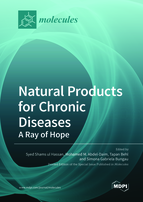Natural Products for Chronic Diseases: A Ray of Hope
A special issue of Molecules (ISSN 1420-3049). This special issue belongs to the section "Cross-Field Chemistry".
Deadline for manuscript submissions: closed (31 August 2022) | Viewed by 30950
Special Issue Editors
2. Department of Natural products, School of Pharmacy, Shanghai Jiao Tong University, Shanghai 200240, China
Interests: natural products; cancer; inflammation; biological activities; molecular docking; ADMET
Special Issues, Collections and Topics in MDPI journals
Interests: pharmacology; drug toxicology; alternative medicine; environmental pharmacology and toxicology
Special Issues, Collections and Topics in MDPI journals
Interests: molecular pharmacology; herbal drugs; unconventional therapies
Special Issues, Collections and Topics in MDPI journals
Interests: pharmacy; pharmacology; public health; medicine; chemistry; clinical trials; nutrition; polyphenols; oxidative stress; antioxidants
Special Issues, Collections and Topics in MDPI journals
Special Issue Information
Dear Colleagues
Developed over centuries to encode biological processes, nature's products are the dawn and predecessors of medicine. Out of the desire to cure diseases, conventional remedies gave a substantial territory to modern chemical techniques much more competent and capable in the development of new drugs. The designated chemotypes of natural components (β-lactam antibiotics obtained from Penicillium sp. and quinoline/iso-quinoline alkaloids obtained from tree bark are prototypical examples of therapeutically appreciated active substances) have proven their ability to act on the broad spectrum of pathogens that continue to significant affect health of the human population, the latter being a huge economic burden worldwide. Products of natural origin, considered to be the core of pharmaceutical armaments, are ready for access compared to synthetic products; moreover, low concern in maintaining an archetype of discovery including fermentation, isolation, structural determination, and biological testing of new pharmacologically active natural compounds must be taken into account. Most studies in the field have been performed to determine the pharmacokinetics and pharmacognostic potential of natural products, and fortunately, researchers have successfully isolated many new compounds. Such substances have been shown to have antibacterial, antiviral, antifungal, antimalarial, antitumor, anti-inflammatory, antioxidant, immunosuppressive, and/or cardiovascular activity, etc. However, the mode of action of many compounds, through which they interfere with human pathogenesis, has not been clarified so far, and this knowledge is essential in knowing and establishing the possibility of transforming chemical molecules into drugs.
The topic of this Special Issue is intended to cover scientific and experimental data, as well as information on drugs, in directions related to the following:
- Capacity of medicinal substances, which have been examined in vitro and in vivo, against pathogenic microbes;
- Mode of action of these medicinal compounds and the basic mechanisms by which natural products function or act;
- Natural products derived with efficient bioactivities;
- Biomolecules derived from natural products used in experimental or clinical studies;
- The new role of natural products in drug targeting.
Original research articles and reviews are equally welcome.
Dr. Syed Shams ul Hassan
Prof. Dr. Simona Bungau
Dr. Mohamed M. Abdel-Daim
Dr. Tapan Behl
Guest Editors
Manuscript Submission Information
Manuscripts should be submitted online at www.mdpi.com by registering and logging in to this website. Once you are registered, click here to go to the submission form. Manuscripts can be submitted until the deadline. All submissions that pass pre-check are peer-reviewed. Accepted papers will be published continuously in the journal (as soon as accepted) and will be listed together on the special issue website. Research articles, review articles as well as short communications are invited. For planned papers, a title and short abstract (about 100 words) can be sent to the Editorial Office for announcement on this website.
Submitted manuscripts should not have been published previously, nor be under consideration for publication elsewhere (except conference proceedings papers). All manuscripts are thoroughly refereed through a single-blind peer-review process. A guide for authors and other relevant information for submission of manuscripts is available on the Instructions for Authors page. Molecules is an international peer-reviewed open access semimonthly journal published by MDPI.
Please visit the Instructions for Authors page before submitting a manuscript. The Article Processing Charge (APC) for publication in this open access journal is 2700 CHF (Swiss Francs). Submitted papers should be well formatted and use good English. Authors may use MDPI's English editing service prior to publication or during author revisions.
Keywords
- natural compounds
- pharmaceuticals
- mode of action
- mechanisms
- medicines
- chronic diseases
- unconventional therapies










